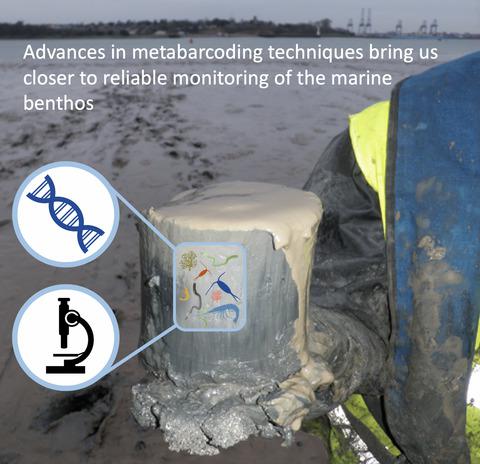当前位置:
X-MOL 学术
›
J. Appl. Ecol.
›
论文详情
Our official English website, www.x-mol.net, welcomes your
feedback! (Note: you will need to create a separate account there.)
Advances in metabarcoding techniques bring us closer to reliable monitoring of the marine benthos
Journal of Applied Ecology ( IF 5.0 ) Pub Date : 2020-07-31 , DOI: 10.1111/1365-2664.13729 Margaux Steyaert 1 , Victoria Priestley 1 , Owen Osborne 1 , Alba Herraiz 1 , Richard Arnold 2 , Vincent Savolainen 1
中文翻译:

元条形码技术的进步使我们更接近对海洋底栖动物的可靠监控
更新日期:2020-07-31
Journal of Applied Ecology ( IF 5.0 ) Pub Date : 2020-07-31 , DOI: 10.1111/1365-2664.13729 Margaux Steyaert 1 , Victoria Priestley 1 , Owen Osborne 1 , Alba Herraiz 1 , Richard Arnold 2 , Vincent Savolainen 1
Affiliation

|
- Reliable and accurate biodiversity census methods are essential for monitoring ecosystem health and assessing potential ecological impacts of future development projects. Although metabarcoding is increasingly used to study biodiversity across ecological research, morphology‐based identification remains the preferred approach for marine ecological impact assessments. Comparing metabarcoding to morphology‐based protocols currently used by ecological surveyors is essential to determine whether this DNA‐based approach is suitable for long‐term monitoring of the marine ecosystems.
- We compared metabarcoding and morphology‐based approaches for the analysis of invertebrates in low diversity intertidal marine sediment samples. We used a recently developed bioinformatics pipeline and two taxonomic assignment methods to resolve and assign amplicon sequence variants (ASVs) from Illumina amplicon data. We analysed the community composition recovered by both methods and tested the effects, on the levels of diversity detected by the metabarcoding method, of sieving samples prior to DNA extraction.
- Metabarcoding of the mitochondrial marker cytochrome c oxidase I (COI) gene recovers the presence of more taxonomic groups than the morphological approach. We found that sieving samples results in lower alpha diversity detected and suggests a community composition that differs significantly from that suggested by un‐sieved samples in our metabarcoding analysis. We found that while metabarcoding and morphological approaches detected similar numbers of species, they are unable to identify the same set of species across samples.
- Synthesis and applications. We show that metabarcoding using the cytochrome c oxidase I (COI) marker provides a more holistic, community‐based, analysis of benthic invertebrate diversity than a traditional morphological approach. We also highlight current gaps in reference databases and bioinformatic pipelines for the identification of intertidal benthic invertebrates that need to be addressed before metabarcoding can replace traditional methods. Ultimately, with these limitations taken into consideration, resolving community‐wide diversity patterns with metabarcoding could improve the management of non‐protected marine habitats in the United Kingdom.
中文翻译:

元条形码技术的进步使我们更接近对海洋底栖动物的可靠监控
- 可靠和准确的生物多样性普查方法对于监测生态系统健康和评估未来发展项目的潜在生态影响至关重要。尽管元条形码越来越多地用于整个生态研究中的生物多样性研究,但是基于形态学的识别仍然是海洋生态影响评估的首选方法。将元条形码与生态调查员当前使用的基于形态学的协议进行比较,对于确定这种基于DNA的方法是否适合长期监测海洋生态系统至关重要。
- 我们比较了基于元条形码和基于形态学的方法来分析低多样性潮间带海洋沉积物样本中的无脊椎动物。我们使用了最近开发的生物信息学流水线和两种分类分配方法,以从Illumina扩增子数据中解析和分配扩增子序列变体(ASV)。我们分析了两种方法回收的群落组成,并测试了在提取DNA之前筛分样品对通过metabarcoding方法检测的多样性水平的影响。
- 线粒体标记细胞色素C氧化酶I(COI)基因的metabarcoding恢复了比形态学方法更多的分类组。我们发现筛分样品会导致检测到的较低的α多样性,并暗示与我们的元条形码分析中未筛分样品所建议的群落组成明显不同。我们发现,尽管元条形码和形态学方法检测到相似数量的物种,但他们无法在样本中识别出相同的物种集。
- 综合与应用。我们显示,与传统的形态学方法相比,使用细胞色素c氧化酶I(COI)标记的metabarcoding提供了更全面,基于社区的底栖无脊椎动物多样性分析。我们还着重指出了用于识别潮间带底栖无脊椎动物的参考数据库和生物信息学管道方面的当前差距,需要在元条形码替代传统方法之前加以解决。最终,考虑到这些限制,使用元条形码解决社区范围内的多样性模式可以改善英国非保护性海洋栖息地的管理。











































 京公网安备 11010802027423号
京公网安备 11010802027423号